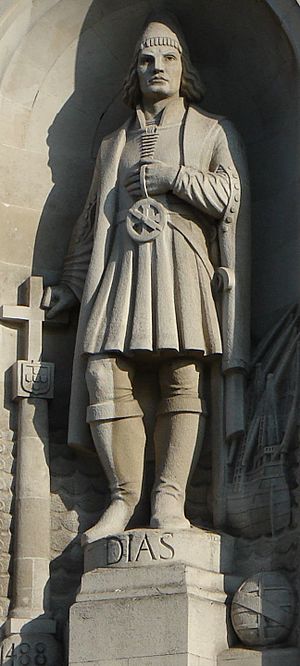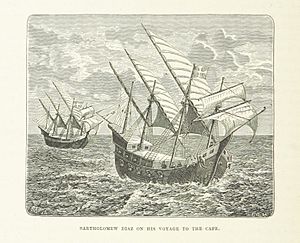Bartolomeu Dias facts for kids
Quick facts for kids
Bartolomeu Dias
|
|
|---|---|

Statue of Dias at the High Commission of South Africa in London
|
|
| Born | 1450 |
| Died | 29 May 1500 (aged approximately 50) South Atlantic Ocean, near the Cape of Good Hope
|
| Nationality | Portuguese |
| Other names | Bartholomew Diaz |
| Occupation | Navigator and explorer |
| Known for | Being the first European mariner to round the southern tip of Africa |
Bartolomeu Dias (born around 1450 – died May 29, 1500) was a brave Portuguese explorer and sailor. In 1488, he became the first European to sail around the southern tip of Africa. His amazing journey showed that ships could travel from Europe to Asia by sea. This discovery changed world trade and exploration forever.
Contents
Early Life and First Journeys
Bartolomeu Dias was born around 1455. His family had a strong connection to the sea. One of his relatives, Dinis Dias, explored the African coast in the 1440s. He even discovered the Cape Verde Peninsula.
It's a bit tricky to know everything about Bartolomeu's early life. This is because several Portuguese sailors had the same name back then. But we know he was a very experienced sailor. He might have traded for ivory along the coast of Guinea as early as 1478. In 1481, Dias joined an expedition to build a fort and trading post. This place was called São Jorge da Mina in the Gulf of Guinea. He might also have been part of Diogo Cão's first trip (1482–1484). That journey went down the African coast to the Congo River.
Sailing Around Africa
Diogo Cão had tried twice to reach the southern end of Africa's western coast. He failed both times. But King John II of Portugal still wanted to find a sea route. In October 1486, he asked Dias to lead a new expedition. Their goal was to find a trade route around Africa's southern tip. Dias was also asked to look for Prester John. This was a legendary Christian ruler believed to live somewhere beyond Europe, perhaps in Africa.
Dias was given two small ships called caravels. Each weighed about 50 tons. He also had a supply ship led by his brother, Diogo. He hired some of the best pilots of the time. These included Pêro de Alenquer and João de Santiago. They had sailed with Cão before.
We don't have many original papers about this famous trip. This is because most sea records were lost in the 1755 Lisbon earthquake and a huge wave called a tsunami. Most of what we know comes from a historian named João de Barros. He wrote about the journey about 60 years later.
The small fleet left Lisbon in July 1487. Like Cão, Dias carried special stone pillars called padrãos. These were used to mark important places they found. They also had six Africans on board. These people had been taken by Cão and taught Portuguese. Dias planned to drop them off along the African coast. They would tell local people about the greatness of Portugal. They would also ask about Prester John.
The expedition sailed straight to the Congo River. From there, they moved carefully down the African coast. They often named new places after saints. When they stopped at what is now Porto Alexandre, Angola, Dias left the supply ship behind. It would wait to give them more supplies on their way back. By December, Dias had gone past the farthest point Cão had reached. On December 8, 1487, they arrived at Golfo da Conceicão (today's Walvis Bay, Namibia).
After slow progress along the Namibian coast, the two ships turned southwest. They sailed away from land. Historians aren't sure if a storm pushed them offshore. Or if they were trying to find better winds on purpose. Whatever the reason, this change worked! The ships sailed in a wide curve around the tip of Africa. On February 4, 1488, after 30 days on the open ocean, they reached the continent's southern cape. They entered what is now Mossel Bay.
The ships continued east for a while. They saw that the coast slowly turned northeast. Dias realized they had reached Portugal's big goal: they had sailed around the southern tip of Africa! Dias's expedition reached its farthest point on March 12, 1488. They anchored at Kwaaihoek, near the Boesmans River. Here, they put up the Padrão de São Gregório.
By then, the crew was tired and wanted to turn back. Supplies were low, and the ships were damaged. Dias wanted to keep going, but all the other officers wanted to return to Portugal. So, he agreed to turn back. On their way home, they sailed close enough to Africa's southwestern coast. This is how they saw the Cape of Good Hope for the first time in May 1488. People say Dias first named it the Cape of Storms (Cabo das Tormentas). But King John II later renamed it the Cape of Good Hope (Cabo da Boa Esperança). This was because it showed a new sea route from west to east was open.
At the cape, Dias put up the last of their stone markers. Then they headed north. They found their supply ship in July, after nine months away. Six of its nine crewmen had died fighting with local people. The ship was rotten with worms. So, they took the supplies they needed and burned the ship on the beach. We don't know many details about the rest of the trip. The ships stopped at Príncipe, the Rio do Resgate (in today's Liberia), and the Portuguese trading post of São Jorge da Mina. Dias returned to Lisbon in December 1488. He had been gone for 16 months.
The Dias expedition explored a thousand more miles of African coastline than any previous trip. It had sailed around the southern tip of the continent. It also showed that the best way to sail south was far out in the open ocean, west of the African coast. This route would be used by many Portuguese sailors for generations. Even with these successes, Dias's return was quiet. There were no big celebrations. At the time, Dias didn't get much recognition for what he had done.
Later Years and Final Voyage
Dias was later honored for his achievements. By 1494, he was working for King John II. He also managed the royal warehouses from 1494 to 1497.
After Dias's successful first trip around Africa, Portugal took a break from exploring the Indian Ocean for ten years. King John faced many problems. His only son died, there was a war in Morocco, and his own health was failing. It wasn't until 1497 that another voyage was planned. Dias was asked to help. Using his experience, Dias helped design and build the São Gabriel and its sister ship, the São Rafael. These were two of the ships that Vasco da Gama used to sail around the Cape of Good Hope and continue to India. Dias joined the first part of da Gama's journey. But he stayed behind after reaching the Cape Verde Islands.
Two years later, Dias was one of the captains in the second Indian expedition. This fleet was led by Pedro Álvares Cabral. This group of ships was the first to reach Brazil. They landed there on April 22, 1500, before continuing east to India. Dias died in May 1500 while captaining a ship near the Cape of Good Hope. Four ships, including Dias's, faced a huge storm off the cape. They were lost on May 29.
Family Life
Dias was married and had two sons. Their names were Simão Dias de Novais and António Dias de Novais. His grandson Paulo Dias de Novais became the first governor of Portuguese Angola. In 1576, he founded the city of São Paulo de Luanda.
Legacy
The Portuguese government built two special beacons to honor Dias and Vasco da Gama. These are called Dias Cross and da Gama Cross. They were the first modern European explorers to reach the Cape of Good Hope. When these crosses are lined up, they point to Whittle Rock. This is a large, underwater rock that is a danger to ships in False Bay.
See also
 In Spanish: Bartolomeu Dias para niños
In Spanish: Bartolomeu Dias para niños


